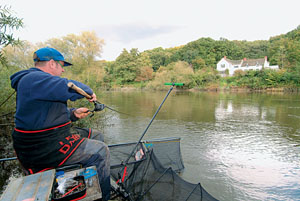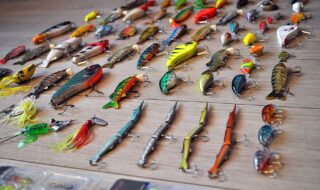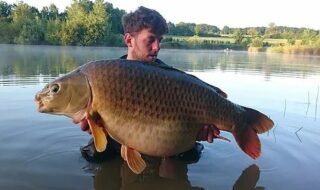I’d been intending to do a feature on the River Severn for a while, so when my original plans for the day fell though I decided on a ‘home’ draw and headed for the KDAA’s Hawksbatch stretch a mile or so upstream of Bewdley.
Lots of the pegs at Bewdley are good for both silver fish and barbel, so to cover my options I picked just such a peg and one that isn’t fished much in the autumn and winter but is great for both the float and the feeder.
The reason that this peg, like many other crackers on the river, isn’t fished much is because it’s at least a good 10-minute walk from the nearest car park.
One of the downsides of the commercial-stillwater revolution is that it is encouraging us to become more and more lazy and as a result, unfortunately, unhealthy I suspect.
Having become used to horrendous walks on the old Worcester Summer League at Oak Meadows and Latham’s Farm, and being drawn literally miles from the nearest car park on countless BAA matches over the years, 10 minutes of flat walking is a breeze as far as I’m concerned.
Walking beyond the first pegs you come to can often improve your sport dramatically. Whenever I need to walk any distance to a peg, I console myself that in the long run it’s helping to keep me alive and healthy and it’s better than paying to be in a gym. Having said all that, my Penrose barrow platform makes these walks considerably easier than they used to be.
I really haven’t got shares in the company, though given the number I’ve seen on the bank this season I wish I had, but my Penrose has transformed my fishing more than any other bit if kit I’ve ever bought.
Misty river
It was a classic, damp and cold late autumn morning when I walked from the car park to the river alongside Dowles Brook.
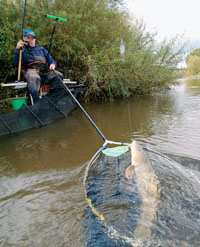 |
| On fast-flowing venues, draw big fish upstream of you and then let the flow bring them into the landing net. |
This brook is only inches deep most of the time, but when the Severn is high it’s full of water and fish – a future feature maybe?
Just above the confluence of the brook and the main river, the view was suddenly dominated by the huge brick stanchions of the old railway bridge and were towering like giants above the mist-covered river.
The bridge once carried the line from the Severn Valley Railway, just across the river, through the Wyre Forest and on to Tenbury.
I stopped for a quick look at the river just above the stanchions, on ‘the cottages’ section of the stretch.
The river here is deep, slow and great for roach and big barbel. However, the peg I fancied was shallower, faster and another five minutes upstream.
It was encouraging to see that the river was about 18 inches above normal level and carrying just a touch of colour – spot-on! Boosted by this, I picked up my pace and quickly got to Peg 29 at the stunning ‘Brideswell Bay’.
The river is extremely wide just a couple of pegs upstream and up to 15 feet deep in places, but in Peg 29 it starts to narrow slightly and shallow up before running over a ford about 50 yards downstream.
Because of the extra water it would have been very difficult to fish the float from the bank, so the first job was to convert the Penrose trolley into a platform and carefully position it in the water.
I always used to stand up to fish, but since getting this platform I sit down everywhere and find that I’m much more comfortable and can therefore fish much more effectively.
One thing I have learnt as a result, though, is that if you’re going to hang your keepnet off your platform in flowing water, you need to use one with open mesh rather than carp mesh.
The water’s drag on the net, and therefore the pressure on your platform, will be reduced considerably.
Extra water
The extra water meant that the river was flowing fairly quickly, so I decided that my main approach would be fairly close in with a stick float.
In most circumstances when fishing the float on the river, you want the main line to sit on the surface so that you can keep it straight behind the float and pick it up off the water quickly when you strike.
To achieve this, spray your spool with a floating-line spray before you set up your rig. In addition, if you have to, rub some mucilin on the first few metres of line above the float.
The bait list for the session included three pints of maggots and two pints of hemp for the float and some 4mm and 14mm halibut pellets for the feeder.
I use a combination of Dynamite and Pelzer pellets for all of my barbel fishing these days and find them to be very consistent and effective.
Matt’s Tackle For Fishing The River Severn
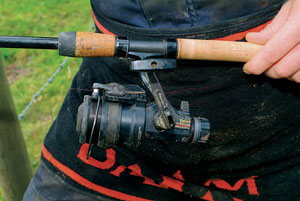 |
| Matt uses fixed spool reels for all his float fishing because the line pays off the spool more smoothly and the retrieve is much quicker. |
|
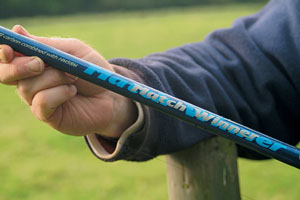 |
| Like many Severn anglers Matt’s a fan of the Daiwa range of rods – this is his Match Winner. |
|
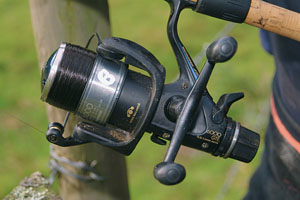 |
| For feeder fishing, this Shimano Baitrunner reel is just the ticket. It’s loaded with 8lb Maxima. |
|
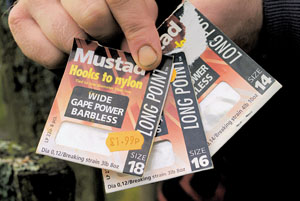 |
| Barbless hooks are used so that the maggots are not damaged and the fish can be unhooked quickly. |
|
Giving it some stick
As always, the first job was to plumb the depth and I was happy that just two rod lengths from the bank there was a good four feet of water, which shallowed to three feet down the peg.
On moving water you need to be sure to plumb the depth all of the way down the peg.
Depths can change dramatically over a short distance and it’s essential to have a clear mental picture of the peg before you start fishing, although on this peg it turned out to be pretty level.
If you find that you have a peg that shallows up downstream it’s time to start getting excited. That’s because food will congregate naturally on the slope and, as a result, so will the fish.
As it was so close, I began to feed the float line by hand with a regular, generous pinch of maggots. I fed the maggots straight in front of me, followed by a pinch of hemp a little further downstream.
Before picking up the float rod, though, I wanted to set a trap for barbel, so I had 10 or 12 quick casts just short of the middle with my feeder, full of 4mm pellets. I also threw 10 or so 14mm pellets a few metres upstream of where I cast the feeder so that they would settle in the right area.
With the trap set, I picked up the float rod, slipped two yellow maggots onto the hook and, with a sidearm flick, cast my stick float a little way down the peg.
Casting downstream makes it easier to keep the line behind the float, which stops it being pulled off line on its way down the peg.
I got straight into a rhythm and fed maggots just behind the float and hemp right on top of it.
I straightened the line behind the float by flicking the rod in a sharp upward and upstream arc and then followed the pace of the float with the rod tip.
The float had only travelled a couple of metres when it buried and I struck into a pleasing, rod-bending fish.
Keeping the rod tip low, I flicked a few more maggots out and began to wind the fish up the peg. An immaculate 8oz dace broke the surface and I risked swinging it to hand (a bad habit that you’ve picked up off Dave Harrell, I suspect, and not to be recommended to anyone fishing in a match. Ed).
How great it is to see these quality dace showing. A lot of us were very worried that the cormorants would have all of them, but there seems to be a lot more showing this winter.
The barbless hook slipped out easily and the maggots were still perfectly intact, so with the fish placed carefully into the keepnet I flicked them back out and continued with the same feeding and line-mending procedure.
River Fishing Top Tips
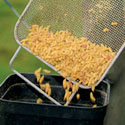 |
Total-Fishing.com Top Tip
Bronze maggots seem to be by far the most effective for this type of fishing but rather than buying bronze maggots and having permanently orange hands, I get yellows and then add a good sprinkling of turmeric a few hours before fishing. This adds colour and flavour to the maggots that dace, chub and particularly roach absolutely love. The turmeric is riddled off just before I start fishing. I also ask the tackle dealer to add a pinch of darker bronze and red maggots so I have alternative hook baits. |
|
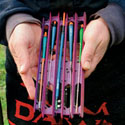 |
Total-Fishing.com Top Tip
If you fish a venue regularly, keeping a variety of different rigs on winders can save loads of time. Simply tie a loop in the end of the rig above the float and attach the main line loop to loop or with a half blood knot tied onto the rig loop. |
|
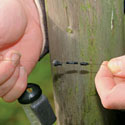 |
| Slip one or two sliding float stops onto the line before you attach your feeder. These can be positioned either immediately above the feeder to create a semi-fixed bolt rig or a foot or so above it. In this position the stops will prevent weed and other rubbish from sliding down and covering your hook bait and will enable hooked fish to dislodge the feeder should it become snagged. Simply allow the line to go slack for 10 or 20 seconds and then tighten back up. Nine times out of 10 the fish will be back, swimming freely in open water. |
|
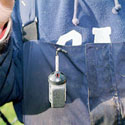 |
| Other than when he’s fishing with very heavy leads, Matt always keeps his feeder in place with an Enterprise adjustable feeder stop. Unlike old-fashioned leger stops, these don’t crimp the line but allow the length of the tail to be easily adjusted. |
|
These are the dace!
Another perfect dace followed and the pattern was set for the next hour with a string of fish between 4oz and 12oz falling to the double-maggot hook bait.
I then went through a period of several biteless casts and I had a couple of runs down without feeding anything at all.
This can encourage fish, which have dropped down the peg, to hunt around and move back upstream in search of food.
This worked perfectly, and after another good dace I started to feed again. A dozen more similar fish quickly followed.
After a couple more biteless casts I stopped feeding again and two casts later the float ripped under and a firm strike was met with solid resistance.
What at first felt like a snag slowly started to move and I was soon bringing a 2lb chub up the peg to the net.
I carried on catching plenty of dace for the next hour and even caught three trout, which jumped right out of the water when I hooked them.
Each time bites slowed, but a couple of casts without feeding soon brought the fish back. Also, swapping one of the yellow maggots on the hook for a red one bought noticeably bigger dace and an occasional switch to either single or treble maggot inspired the odd chub to have a go as well.
When bites slowed again I decided to see if any barbel had arrived on my pellets.
Matt’s Baits For Fishing The River Severn
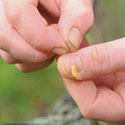 |
| Double maggot is the standard approach but if the fishing is hard, or to fool wary chub, a single can be better. |
|
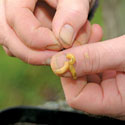 |
| You can sometimes pick up better fish, particularly in coloured water, by trying three maggots. |
|
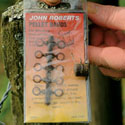 |
| If you don’t fancy drilling your pellets, they can be attached onto the hook with an appropriately sized bait band. |
|
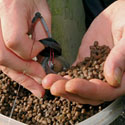 |
| Matt fed Dynamite and Pelzer pellets on the feeder line but left it two hours before fishing it. |
|
Bronze battlers
I slipped a 14mm pellet, drilled and mounted on a Stonfo rubber hair using a baiting needle, onto the size 10 hook, filled the feeder with 4mm pellets and cast the rig underarm to the prebaited area.
The rod had only been in the rest for a minute when a couple of sharp taps on the tip showed that there were fish on my bait. These taps are usually from barbel nudging and mouthing the hook bait, although, on occasions, the fish will nudge and actually pick up the feeder.
Just 30 seconds later another tap was quickly followed by the tip firmly pulling round.
With adrenaline pumping, I picked up the rod and tightened down to the unmistakable lunges of a hard-fighting barbel – result!
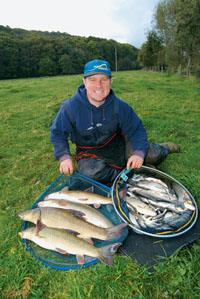 |
| One of those red letter days for Matt on his favourite River Severn at Hawksbatch. |
Now I have hooked my fair share of Severn barbel, and one thing I have learnt is that, when you are playing barbel in pegs without major snags, it pays to keep the rod tip low so that the fish can stay near the bottom as you bring it towards you.
If you don’t do this, you will be doubling the pressure on your gear by fighting to bring the fish towards you and up in the water at the same time, increasing the chance of a breakage quite significantly.
I tend to have my clutch set quite tight, so that it only comes into play if there is a very sudden and powerful lunge. As a result, I play most of my fish by backwinding the reel handle.
Keeping the tip low and supporting the rod just above the butt ring, I could feel every pulsating lunge of the fish in the fast current and the serious bend in the rod was, as always, a sight to behold.
By carefully and repeatedly pulling the fish upstream in this way, and then winding down to it, I managed to eventually bring it slightly upstream of where I was sitting.
In fast water this is really important because, when the fish eventually tires and comes to the surface, the flow catches it and sweeps it down into the waiting landing net.
Trying to drag a large fish upstream on the surface of fast-flowing water is almost impossible and puts enormous strain on the tackle.
Finally, an immaculate 6lb bronze, torpedo-shaped fighting machine slipped into the net – “… and relax!”
Removing the hook with one of my oversized disgorgers, I noticed that the fish’s mouth was completely unmarked and I am pretty certain it had never been caught before.
Given the number of barbel that I’ve caught, or heard of being caught, this season, that I also believe have never been hooked before, it makes you wonder just how many are in the river and why, at times, they just won’t feed.
Returning fish
I gently slipped the fish into the keepnet, making sure that it was upright and happy to swim down the net before recasting.
I don’t usually use a keepnet when I’m fishing for barbel, unless it’s a match, and I urge you to do the same.
I guarantee that returning fish generally doesn’t spook the others in the shoal.
This was confirmed to me when my good mate, Mark Jones, and I sat next to each other and caught 22 barbel, each of which was carefully put straight back into the water.
Whenever you are lucky enough to catch a barbel, return it to the water as soon as possible and hold it submerged, facing the flow until it kicks to swim away.
If you do need to put barbel, or any other fish for that matter, into a keepnet, you must ensure that at least half of it is completely covered by water. If you can’t, do not put fish into it.
In the next five casts I missed two good bites and caught three more similarly hard-fighting Severn barbel.
This quick-fire action shows the benefit of baiting an area of your peg and then leaving it for an hour or two.
This allows the fish to find the bait, settle on it and get really confident before you try to catch them.
How To Hook Hard Pellets
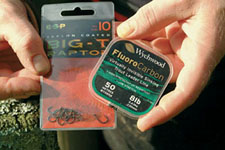 |
| 1 Don’t mess about when it comes to terminal tackle. Matt uses 8lb hooklengths and size 8 Raptor hooks. |
|
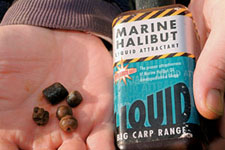 |
| 2 To add some extra drawing power to the hook bait, Matt dunks the pellets in this attractant. |
|
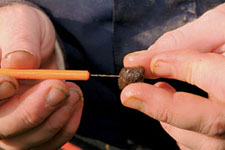 |
| 3 Generally, for barbel he fishes with 14mm pellets which must be carefully drilled. |
|
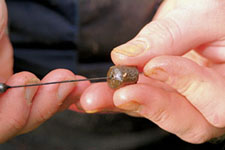 |
| 4 Once drilled, push the baiting needle through the hole created. |
|
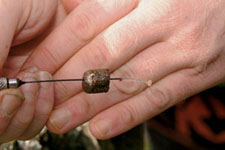 |
| 5 The Stonfo rubber hair Matt prefers is grabbed using the hook on the baiting needle. |
|
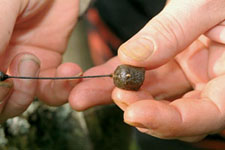 |
| 6 He draws the rubber hair through the hole in the pellet until it just shows at the top. |
|
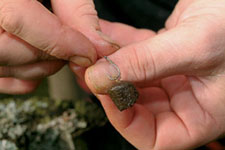 |
| 7 The hook point is pushed through the ‘bulb’ of the rubber hair. It’s now ready to fish. |
|
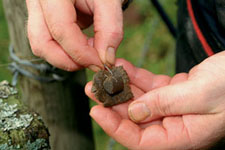 |
| 8 For added attraction, try wrapping some pellet paste around the pellet; it’s effective in coloured water. |
|
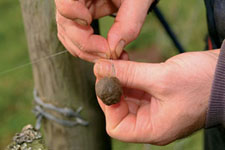 |
| 9 The paste is made out of ground-up pellets mixed with egg. |
|
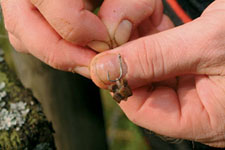 |
| 10 Clusters of 4mm pellets superglued onto a rubber hair can also be deadly. |
|
Severn in great form
A couple of biteless casts signalled the end of a fantastic session.
I’m sure that if I’d have carried on fishing I’d have caught more barbel and maybe some big chub, but I was more than satisfied with more than 20lb of glistening silver fish and four battling bronze barbel.
This was a truly golden day but only reflects how well the Severn is fishing this season.
Three days before this feature I had a similar catch from a different section of the stretch but the 20lb of silvers were all roach and the barbel were all between 6lb and 9lb.
Believe me – rumours of this river’s demise are greatly exaggerated and whether your ‘thing’ is running a float down for silvers or doing battle with a fighting-fit bronze barbel, you really should give it a go.
When it’s fishing well, there is no better venue in the country.
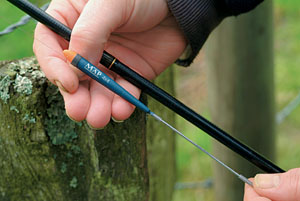 Stick-Float Tips
Stick-Float Tips
When choosing the right stick float, consider the following rules of thumb:
SHOT: Use the equivalent of one No4 for every foot of water.
SHAPE: Use a dome-topped float if the water is ‘boilie’, if visibility is an issue or you are catching well. Use a shouldered pattern if the water is flat and the fish are shy.
STEM: I use an aluminium stem for most situations, but use cane if I’m fishing on the drop with small shot. If I have to cast some way to reach the flow, then I opt for a lignum or plastic-stemmed float.
Matt’s Set-Ups
Feeder Set-Up
Rod: Daiwa Match Winner 11ft/13ft Power Feeder (fished at 13 feet)
Reel: Shimano 6000 Baitrunner
Line: 8lb Maxima
Feeder: 50gr Kamasan Blackcap
Hook: Size 10 ESP Big T
Hooklength: 8lb Wychwood Fluorocarbon
Float Set-Up
Rod: 13ft Normark Camaro
Reel: Daiwa 1657 Autobail
Line: 3lb Maxima
Float: MAP 4No4 dome-topped, alloy-stemmed stick, shotted with No6s, six inches apart and a No8 dropper shot on the hooklength
Hook: Size 16 Mustad Wide Gape Power Barbless to 0.12mm nylon hooklength
Venue Fact File
River Severn, Hawksbatch, near Bewdley
The stretch is one mile north of Bewdley town and has 121 pegs, spread over two and a half miles, and holding barbel, chub, roach, dace, perch, carp and a few trout
Controlling club: Kidderminster and District AA
Contact: Mick Millinchip, tel: 01562 753471
Restrictions: Tickets to be purchased before session, all litter to be removed, no night fishing
Tickets: Right now you need a club book but from next season you will be able to buy a £4 day ticket. A
12-month membership card is £25 for adults with concessions £15. A seven-day ticket is £7 and club-match bookings are taken
Matches: Open matches are held every Wednesday and Saturday from June to September inclusive. There are also matches every Wednesday and Sunday from October to mid-March
Total-Fishing.com


 Stick-Float Tips
Stick-Float Tips
